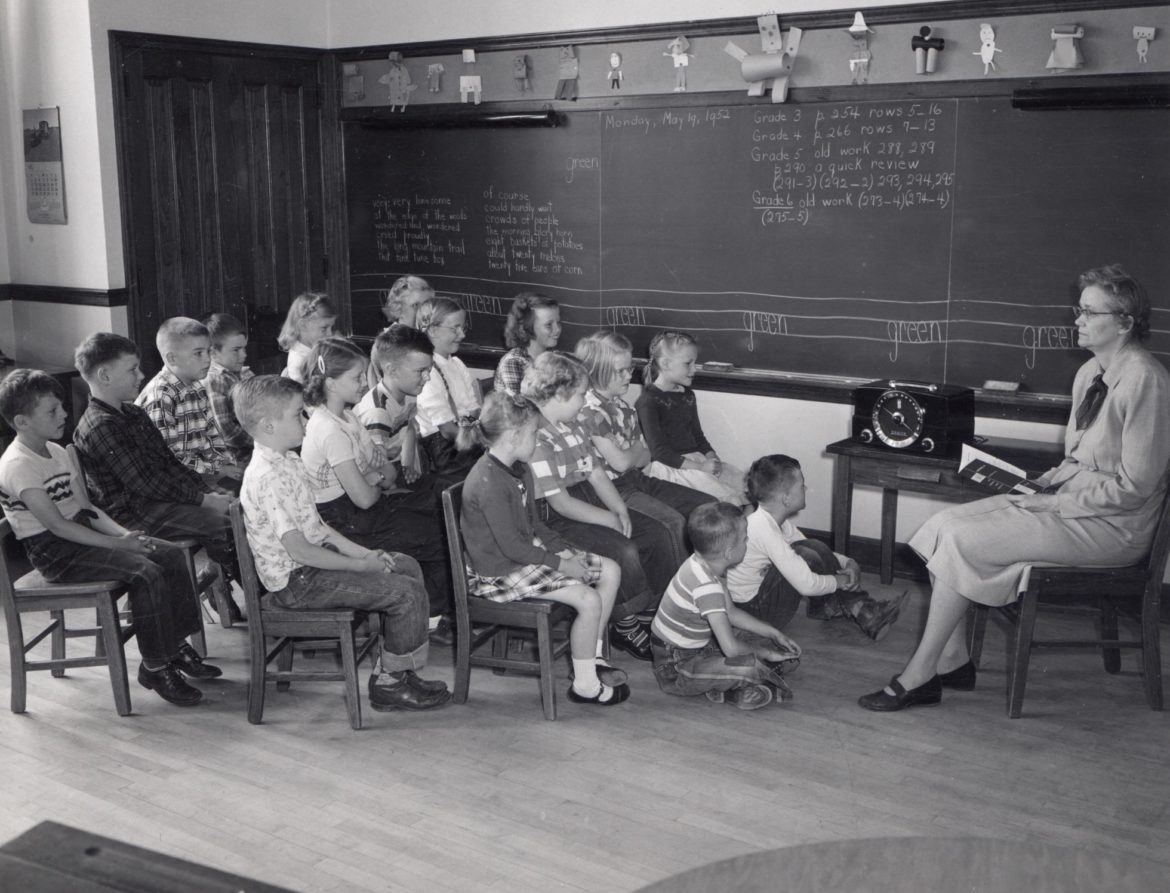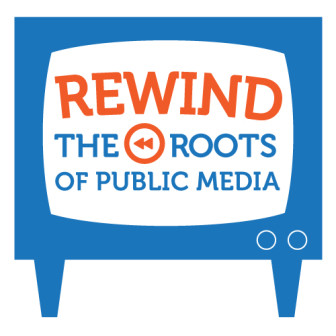Roots of public broadcasting can be found in Wisconsin’s vision

Children in a Wisconsin classroom listen to lessons broadcast by radio. (Photo courtesy of the University of Wisconsin-Madison Archives (ID S05822))

Children in a Wisconsin classroom listen to lessons broadcast by radio. In its time, WHA aimed to educate everyone in a state in which much of the population had not attended high school. (Photo courtesy of the University of Wisconsin-Madison Archives (ID S05822))
For years, Wisconsin’s WHA Radio claimed that its first broadcast of voice and music in 1917 made it “the oldest station in the nation.” Whether or not that claim is valid, the University of Wisconsin station’s 100th anniversary does mark the beginning of not-for-profit public service broadcasting in the United States. WHA and public broadcasting share their 100th birthday because the concepts that define public broadcasting grew from WHA’s “first broadcast” in 1917.
 Other universities experimented with radio early in the 20th century, but few saw much use for the technology that intrigued their engineers and physicists. Institutions active in agricultural extension did see the technology’s potential to deliver to farmers and their families useful tips, weather and market information. Indeed, such information found an early home on WHA.
Other universities experimented with radio early in the 20th century, but few saw much use for the technology that intrigued their engineers and physicists. Institutions active in agricultural extension did see the technology’s potential to deliver to farmers and their families useful tips, weather and market information. Indeed, such information found an early home on WHA.
The vision for WHA, however, went beyond agricultural extension. The station emerged in 1917 at the end of the progressive era in the state and at the university most closely identified with that early 20th-century reform movement. “The Wisconsin Idea” made the boundaries of the university the boundaries of the state and gave purpose to the broadcast apparatus that emerged from the university’s physics lab.
The term “The Wisconsin Idea” came from the title of a book that UW political science professor Charles McCarthy published in 1912. It marked the zenith of the progressive movement. A hundred years later, Sen. Bernie Sanders echoed the language and concepts that McCarthy used in The Wisconsin Idea. McCarthy’s book attacked the corrupting power of moneyed interests and an unrestrained profit motive. He foresaw the day when a small group of powerful families would own most of the wealth as the rest of the population drifted into poverty. His book explained how Wisconsin progressives used state government and the state university to “empower” the middle class against the rich.
McCarthy described legislation that attacked concentrated economic power through laws regulating business, establishing workers’ compensation, protecting the environment and limiting child labor. Other laws addressed political corruption by establishing a professional civil service system. Some legislation gave power directly to the people through primary elections, the direct election of U.S. senators, and the power to recall elected officials. Theodore Roosevelt’s introduction to McCarthy’s book described Wisconsin as “literally a laboratory for wise experimental legislation aiming to secure the social and political betterment of the people as a whole.”
Before publishing his book, McCarthy had organized the University of Wisconsin’s general extension division to promote his progressive vision. In addition to offering correspondence courses, the division organized public lectures and “fair and impartial debate” on important issues. McCarthy insisted that public tax money pay for these activities to keep them free of the corrupting power of private money. General extension put the university at the center of public life.
Also in 1912, university president Charles Van Hise called a conference of newspaper editors and critics to discuss the corrupting influence of “commercialism in journalism” — what he saw as the quest for profit over the search for truth in the journalism of the day. Conferees endorsed not-for-profit alternatives to commercial journalism, suggesting that universities, governments and foundations might fund and operate them. They did not envision broadcasting in 1912, but five years later university physicists gave them that instrument.
However, by the time WHA became fully operational in the decade after World War I, progressivism had faded as a national movement, and commercial interests dominated radio. Nonetheless, an attenuated Wisconsin Idea continued to pervade Madison. The state government and the university set out to use radio to create a more enlightened and engaged community: Ultimately, they built a network of nine FM stations and another AM station from the original WHA to create the Wisconsin State Broadcasting Service. Popularly known as “the State Stations,” the FM network took to the air 20 years before the Public Broadcasting Act of 1967.
Why did this state and its university make such a major investment? Programs for schools were only part of the answer. University President Glenn Frank wrote that radio programming needed to promote “intelligence and moral responsibility” in the population as a whole and should encourage understanding among diverse groups.
A co-conspirator with Professor McCarthy in developing the Wisconsin Idea, Professor William Lighty, volunteered as WHA’s first program director. He specifically rejected airing formal courses in favor of “broadcasts that have a general human interest appeal for the vast invisible audience, and at the same time to interpret the true spirit, the life and the work of the university.” Essentially, Lighty wanted to deliver a broad liberal education to everyone in a state where much of the population had not attended high school and a surprising number were illiterate. He said he was “rationalizing” all citizens.
Lighty wanted programs that were accessible and entertaining as they sought to educate and inform. Extending this philosophy, one of his successors declared that “though produced amid academic surroundings, the programs are not permitted to become high brow.” President Frank reminded programmers how easily listeners could turn “from dull quality to interesting frivolity with a simple twist of the dial.”
True to the progressive spirit in which it was conceived, WHA and the State Stations made an unusually strong commitment to fostering democratic debate and broad public participation in the political process. Some of the staunchest advocates for the State Stations justified them primarily on their service to a functioning democracy. In the early 1930s, WHA created the “Political Education Forum.” It provided free and equal airtime to all candidates for statewide political office — progressive Republicans, stalwart Republicans, Democrats, Socialists, even Communists. The word “forum” turned up in many program titles as the station organized debates and discussions on issues of public concern. More than other noncommercial broadcasters of the time, Wisconsin’s State Stations combined democratic access with authoritative education — and enough entertainment elements to attract and hold listeners.
In 1967, fifty years after WHA first broadcast voice and music, Congress enacted the Public Broadcasting Act. The legislation was part of President Johnson’s Great Society, an array of reforms and government activism that echoed the progressive era initiatives exemplified in the Wisconsin Idea. The Carnegie Commission report that shaped the Public Broadcasting Act promised a societal transformation similar to that envisioned by Professor Lighty. Like the founders of WHA, the Carnegie Commission specifically rejected formal courses and narrow instruction in its vision of public broadcasting. Like the founders of WHA, the commission sought a more enlightened populace, a more integrated community and a better-functioning democracy.
In another parallel with the progressive era, however, the Great Society was quickly exhausted by a tragic war. Vietnam ended the optimism of the Great Society as surely as World War I disillusioned the progressives. Both reform movements ended, but the broadcast institutions they created survived with diminished ambitions.
While public broadcasters rightly defend their programming against charges of “liberal bias,” tax-supported public broadcasting is an inherently liberal institution. Created by progressives early in the 20th century and greatly expanded by another generation of progressives in the 1960s, noncommercial public service broadcasting supports progressive values. It serves a broad public interest beyond the array of individual interests served commercially. It promotes an educated populace and participatory democracy. It seeks to empower ordinary citizens. From its birth in The Wisconsin Idea a century ago, public broadcasting is a progressive enterprise that defies the gospel that the economic marketplace provides everything society needs and that profit is the only motive that serves the public good.
Jack Mitchell was the first employee of NPR and the first producer of All Things Considered. He spent most of his career in Wisconsin, however, as director of Wisconsin Public Radio and, later, as Professor of Journalism at the University of Wisconsin-Madison. He is the author of Listener Supported: The Culture and History of Public Radio (Praeger, 2005) and Wisconsin on the Air: 100 Years of Public Broadcasting in the State that Invented It (Wisconsin Historical Society Press, 2016). This essay was based on the latter.
This commentary appears as part of Rewind: The Roots of Public Media, our series of historical essays about public media created in partnership with the Radio Preservation Task Force. The RPTF is an initiative of the Library of Congress. Josh Shepperd, assistant professor of media studies at Catholic University in Washington, D.C., and national research director of the Radio Preservation Task Force, is Faculty Curator of the Rewind series. Email: shepperd@cua.edu









Hi, Jack. Interesting article and makes the point about how critical the role of land grant universities (and particularly my alma mater) has been in the development of public broadcasting. As I write this, OPB celebrates its 94th year today, having been founded on December 7, 1922 at what is now Oregon State University, another great land grant university.